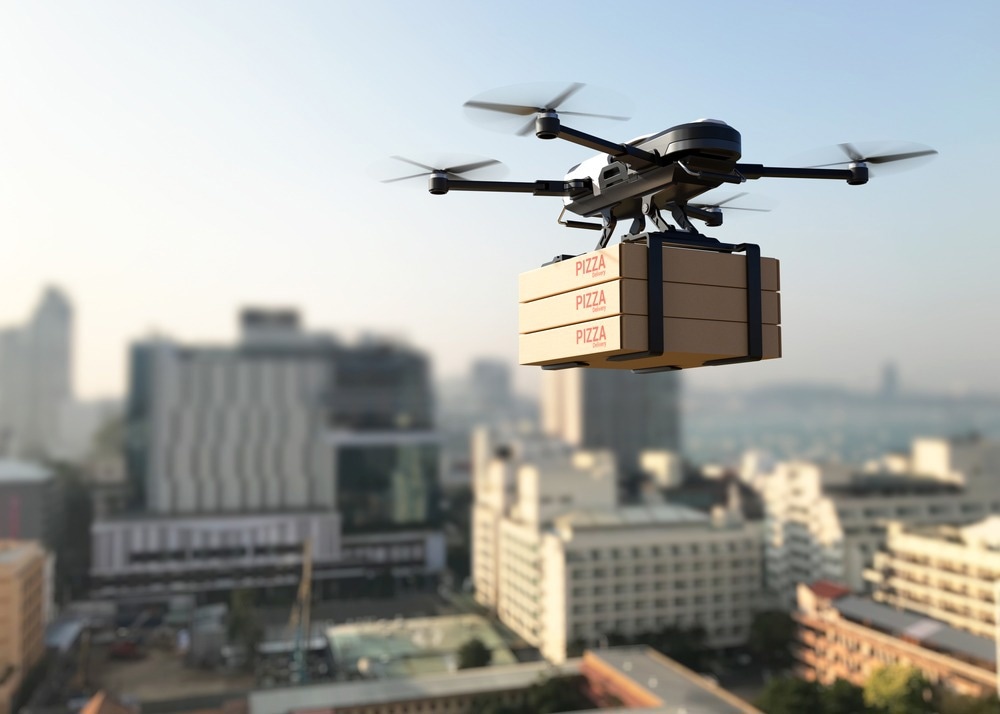Some companies are deploying autonomous food delivery robots in place of human delivery drivers. These robots can potentially improve the sustainability, cost-effectiveness, and safety of food delivery.

Image Credit: Es sarawuth/Shutterstock.com
What Are Food Delivery Robots?
Food delivery robots are autonomous vehicles that deliver food to customers without human intervention. Advancements in mobile technology, artificial intelligence, and robotics have facilitated their development.
There are two main types of autonomous food delivery robots: ground-based and aerial vehicles. These robots use cameras, GPS, and LiDAR (Light Detection and Ranging) sensors to navigate their surroundings.
LiDAR sensors use light pulses to measure distance, allowing for 3D mapping of the environment, cameras can recognize obstacles and surface types, and GPS enables the robot to determine its exact location. Food delivery robots are powered by electricity and may be monitored by someone in case any issues occur during the journey.
The commercial use of food delivery robots began in the early 2010s and has since increased rapidly. The global COVID-19 pandemic was a particular driver of this growth as it prompted a significant increase in demand for food delivery services.
Current Usage of Food Delivery Robots
Although they are not yet commonplace, several different food delivery robots have already been developed and deployed to optimize delivery processes.
Developments include those manufactured by Starship Technologies. Starship has recently deployed fleets of food delivery robots across university campuses in the United States, including the University of Pittsburgh, the University of Tennessee, and George Mason University.
The food delivery robots are each equipped with six wheels and move along the ground at maximum speeds of around 4 mph. This speed allows them to travel through pedestrian areas safely to deliver to the students and staff across campus. Each robot weighs roughly 25kg and can carry approximately 9kg of food.
One of the fastest food delivery robots available is the R2, developed by autonomous vehicle startup Nuro. The R2 can travel at a maximum speed of 45mph and was the first driverless car approved by the US Department of Transportation.
The R2 is roughly half the size of a standard car and contains a large compartment for carrying goods. Recently, Nuro partnered with Domino’s Pizza to deliver pizzas to customers in Houston, Texas. Select customers can opt for an R2 delivery and are sent a unique pin that allows them to retrieve their order from the robot.
Delivery robots zip around the streets of Cambridge
Video Credit: The Telegraph/YouTube.com
Food delivery robots could also deliver food to conflict and disaster zones by early next year. The first use of such vehicles is due to occur in South Sudan, where 7.7 million people are facing food insecurity, and flooding makes it difficult to deliver aid. The trucks currently used to deliver food to South Sudan are amphibious and can each carry 1-2 tonnes of goods. However, they require a driver.
According to the United Nations, attacks against aid workers have increased in recent years, and the World Food Programme has already lost three of its workers in Sudan this year. Using driverless food delivery robots could help to protect humanitarian workers from danger.
Aside from the safety benefits of using food delivery robots to deliver to dangerous areas, there are many other advantages of this technology, as well as some issues that need to be overcome before it is used more widely.
The Pros and Cons of Food Delivery Robots
Food delivery robots are a sustainable transport method, as they are powered by electricity and therefore do not emit carbon dioxide or hazardous pollutants. Thus, they will enable companies to reduce their carbon footprints while providing the same level of service.
Using food delivery robots is also more cost-effective than employing human delivery drivers, as companies do not have to spend money on driver’s wages or expenses such as insurance. These cost savings can then be passed down to customers.
Additionally, food delivery robots could improve the availability of delivery services and the consistency and efficiency of journeys, as they can be programmed to follow a set route for each delivery.
However, there are some concerns with the use of food delivery robots. These vehicles often face challenges when navigating complex environments, and poor weather conditions and power outages can seriously impact robot performance.
Most food delivery robots can only be used for short journeys, and there is a possibility that they will be stolen while completing a delivery. Many emit a high-pitched noise if anyone gets too close, but this anti-theft system is far from perfect.
Even if these problems are resolved, food delivery robots may have an undesirable impact on the food industry. Previously, some companies have used new technology to reduce costs and increase profit without paying staff more. Frequent use of food delivery robots could lead to similar problems.
There are also serious concerns about the possibility of companies completely replacing human delivery drivers with food delivery robots. Although it is not yet feasible, this problem will require careful consideration, as will the regulatory and legal issues associated with deploying autonomous food delivery robots on public footpaths and roads.
Overall, there is potential for food delivery robots to revolutionize the future of the food industry. However, this will only be a possibility if these issues are resolved.
References and Further Reading
Farge, E. (2023). UN Food Aid Deliveries by AI Robots Could Begin Next Year. [Online] Reuters. Available at: https://www.reuters.com/technology/un-food-aid-deliveries-by-ai-robots-could-begin-next-year-2023-07-07/
(2023). The Current State of Development of Food Delivery Robots. [Online] Reeman. Available at: https://www.reemanrobot.com/news/the-current-state-of-development-of-food-deliv-64726224.html
Mahendra, S. (2023). Food Delivery Robots: Will they Go Beyond the UT Campus? [Online] Artificial Intelligence +. Available at: https://www.aiplusinfo.com/blog/food-delivery-robots/#h-dax-delivery-robots
Disclaimer: The views expressed here are those of the author expressed in their private capacity and do not necessarily represent the views of AZoM.com Limited T/A AZoNetwork the owner and operator of this website. This disclaimer forms part of the Terms and conditions of use of this website.